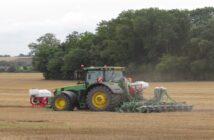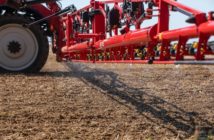Early results from a nationwide survey are indicating high incidences of TuYV infection in the current oilseed rape crop.
Carried out by Dr John Walsh of Warwick University on behalf of breeders Limagrain UK, the survey which will be completed by the end of May, will provide a comprehensive indication of TuYV infection hotspots across the country. TuYV is thought to be the most important, yet least understood viral disease in oilseed rape.
“Results so far are showing generally high levels of infection; results from the south of England have detected incidences of as high as 80%, in Somerset incidences of up to 74% and in Yorkshire incidences of up to 72%, whereas in Cardiganshire we found incidences of up to 46%.”
Dr Walsh believes that these high incidences have come about as a result of the high numbers of aphids flying last autumn and to some extent the lack of neonicotinoid seed treatments.
“What we do know is that high incidences of TuYV infection lead to fairly substantial yield losses and with levels such as those indicated in the survey so far, we could be looking at yield losses of as much as 30%,” says Dr Vasilis Gegas, senior oilseed rape breeder with Limagrain.
William Compson, oilseeds product manager with Limagrain, recognizes that the problem with TuYV is that you don’t usually see the symptoms until spring. “Early symptoms of TuYV are expressed by intense purpling of the leaves; later symptoms of interveinal yellowing and reddening of leaf margins are not usually expressed before stem extension and can easily be confused with other stress symptoms and nutritional deficiencies, which is why the effect of the virus is underestimated.”
Looking ahead to next autumn and what this means for the oilseed rape crop, Mr Compson notes that whilst foliar insecticides such as Plenum, can offer some solution to the aphid problem, there is widespread resistance to pyrethroids and primicarb to consider.
“This means that variety choice will be even more critical than ever and will require a change in mind set where resistance and agronomics play an increasingly crucial role in order to protect yield,” he says.
Amalie remains the only commercially oilseed rape variety with resistance to TuYV on the market, and the variety was re-submitted as a candidate in the 2014-2015 HGCA RL trials based on this trait.
“We are seeing the benefits of this resistance in field trials during our sampling,” adds Dr Walsh. “One of the farms in Lincolnshire where we conducted our sampling showed incidences were between 36-62%, depending on which field was sampled. However, this particular farmer had some Amalie growing adjacent to these non-Amalie fields and the incidence in the Amalie crop was only 7% – a drastic reduction.”
Amalie is a conventional OSR variety that offers a gross output similar to the widely grown variety, DK Cabernet. “However, our own trials using untreated seed over the last four years have clearly shown that where TuYV is present, Amalie yields 10% more than non-resistant varieties,” says Mr Compson.



